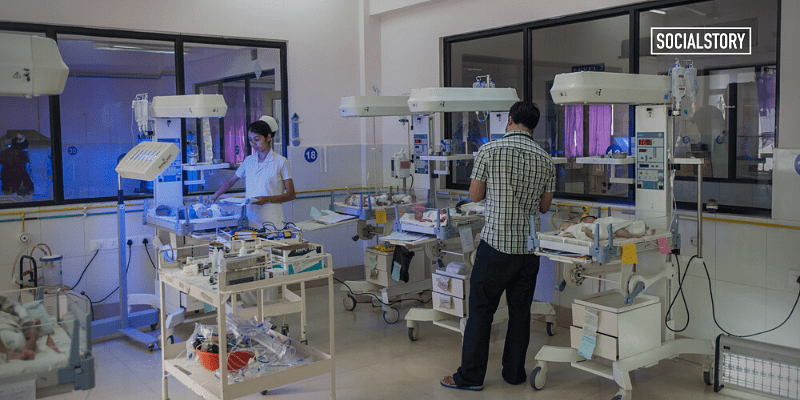As a patient, at one point or the other, we have all expected that we are treated with care. We have expected the physician to listen to our concerns earnestly, and give us the required remedy for our ailment.
This is how the ideal physician-patient interaction should be when the only thing that the physician is concerned about is the patient, without worrying about the mammoth paperwork that is accompanied by each patient visit.
Unfortunately, such ideal interactions are rare to come by. Physicians across the world are burdened with tremendous administrative tasks that take away precious time from direct patient care. According to a study, 42 percent of physicians in the US reported feeling burnt out. Most of this burnout has been attributed to the administrative work that is accompanied by their day-to-day responsibilities.
Additionally, 79 percent of these physicians confirmed that their burnout started even before the pandemic. More and more physicians are feeling the burden of these tasks, therefore being unable to devote time for direct patient care. Physician burnout has been proven to impact the quality of care as well.
According to WHO data, around half of the world today does not have access to essential healthcare services and about 800 million people have spent 10 percent of their household budgets on healthcare for themselves or family.
In developing countries like India, there is a need to make healthcare available and affordable to all, therefore making it important for healthcare systems to find solutions that can be made easily available in remote and rural areas.
For healthcare systems to create sustainable healthcare solutions for population health, it is important to consider three major aspects — quality of care, affordability, and accessibility.
Quality
As healthcare systems focus on the quality of care, one of the most essential aspects is to reduce medical errors. There are many levers to potentially assess the quality of care for patients, one such framework is the quality tripod that hinges on structure, processes, and outcomes.
Structures are the physician spaces and resources utilised during patient care, processes are the series of interventions deployed during patient care, and outcomes are the results of the care administered to the patients.
Reliable data that can help us create insights into how a patient journey takes effect from the point of first interaction (structure) to the last point (outcomes) can help us understand, interpret, and improve upon how we approach care.
Patient safety is another aspect of improved quality of care. There are many debates around the approved or accepted quality measurement framework that could be applied in all situations. However, such macro aspects can be inspected to get a sense of the quality of care that is being delivered to patients.
Adverse events may occur during patient care that can be attributed to multiple reasons. Today, we can be in control of many of these repetitive manual tasks with technology.
Managing these events has become increasingly possible due to digital health records and AI’s predictive analysis. Thereby improving the quality of care as healthcare professionals get insights into patient’s historical data, chronic ailments, comorbidities, medicine allergy, diagnostics reports, and more.
Ultimately, helping physicians with access to critical information at the click of a button. Outcome-based care is fundamentally the direction that most regulatory authorities are taking as population health solutions around the world. India needs to invest in it as well.
India needs to prepare to go digital in a big way, and thereafter, use this data effectively to come up with relevant solutions. The government directive for digitisation is an affirmation of India’s commitment to work towards population health solutions.
Affordability
Globally, for close to 100 million people, healthcare expenses are so high that they can threaten to push them below the line of poverty. The cost of healthcare and its affordability, therefore, is a rising concern. With a growing ageing population, and focus on bettering the quality of care delivered at lower costs, the US continues to invest 66 percent of US healthcare costs into managing patients with chronic conditions.
The pandemic has further established that the patients, as well as providers, are looking for affordable healthcare that allows patients to pay for comfortably, as well as allows for healthcare organisations to run commercially viable establishments. Hence, it is important that provider enterprises look for cost effective solutions.
There is a direct correlation between how healthcare organisations create value for their patients as they continue to look at lowering the cost of care and improving quality. True value of care can be achieved by shifting focus from structure and processes to outcomes, therefore creating patient centric solutions.
Healthcare organisations need to work with regulatory authorities to establish this value chain within the healthcare ecosystem, where responsibility of the cost of care is shared amongst all involved parties — the government, insurance companies, the patient, and the providers.
The best way to participate in the value creation for provider enterprises is to begin investing in outcomes driven measures that allow more direct care of patients, like contracting all administrative and ambiguous fixed costs externally. Therefore, allowing them to have more control on expenses.
As providers invest in technology, they could reduce the burden of ‘unnecessary expenses’ like repetitive tests, preventable procedures, and diagnostics thereby reducing costs. Patient information and data can be accessed through digitised resources, allowing providers to limit expenses to only necessary and relevant. Another aspect is the availability of skilled resources.
Availability of skilled resources is inversely proportional to the affordability of the service. As more and more skilled people join the value chain, the cost of hiring those services will come down. Some of the looming challenges that healthcare providers need to overcome to come up with cost-effective solutions are pursuing scalability on high fixed-costs like people, process, and technology infrastructure to respond to rapidly evolving care continuum.
Accessibility
India is a large country. Both from the number of people to the geographic expanse point of view. It is also lopsided from a healthcare accessibility aspect, with urban India buzzing with hi-tech medical technologies, to rural India struggling for even the most basic healthcare intervention.
In the US, telemedicine gained immense popularity in recent times due to the pandemic. Tele consultations have become increasingly popular and reliable, making them acceptable by payers. Closer home, it is a long way to go in terms of acceptability as a major solution for patients with chronic conditions and post-visit care.
Healthcare organisations across the world are adopting digitisation of patient records, therefore increasing not just patient accessibility to care but expanding shareability, access and accuracy of patient data between care providers. Can we imagine a world where a patient from a rural area in India is able to consult with a specialist from anywhere in the world?
Where the physician has access to all patient records giving them insights into the patient’s history, all diagnostics, allergies, and other relevant information, with the ability to treat the patient even with thousands of miles between them. The truth is that this is possible, however there is immense responsibility with carrying patient data.
The regulatory authorities need to have security protocols in place that protect the patients’ health information at the same time as they empower them to get access to better healthcare.
Healthcare organisations need to have technology infrastructure that prioritises patient safety, as it enables the power of IoT to better the care provided to them.
The three most defining aspects of healthcare — quality, affordability, and accessibility — is the fulcrum of how we architect patient centric solutions in the future. They all point at rapid and urgent adoption of technology. It will be a brave step for India to move in this direction.
At the moment, providers are overburdened with administrative tasks, taking time away from patient care and relationships. There is lack of sufficient clinical and administrative resources, burdening providers further. There are solutions available where providers can look for unburdening these administrative tasks, as they concentrate on what they do best — caring for the patients.
Trustworthy, integrated partners that can pick up these aspects of patient care, improving patient experience, mitigating errors, and unburdening physicians, is the light at the end of the tunnel for provider enterprises. Consequently, enabling a differentiated approach for the patients by enabling a patient-centric, provider-led care delivery model.
This calls for us — regulatory authorities, government, and healthcare systems — to collectively rise to the challenge and transform healthcare.
(Disclaimer: The views and opinions expressed in this article are those of the author and do not necessarily reflect the views of YourStory.)




![Read more about the article [Funding roundup] iSprout, Healthfab, Rage Coffee, Stage3, others raise early-stage deals](https://blog.digitalsevaa.com/wp-content/uploads/2021/12/Image03w0-1640781482458-300x150.jpg)





